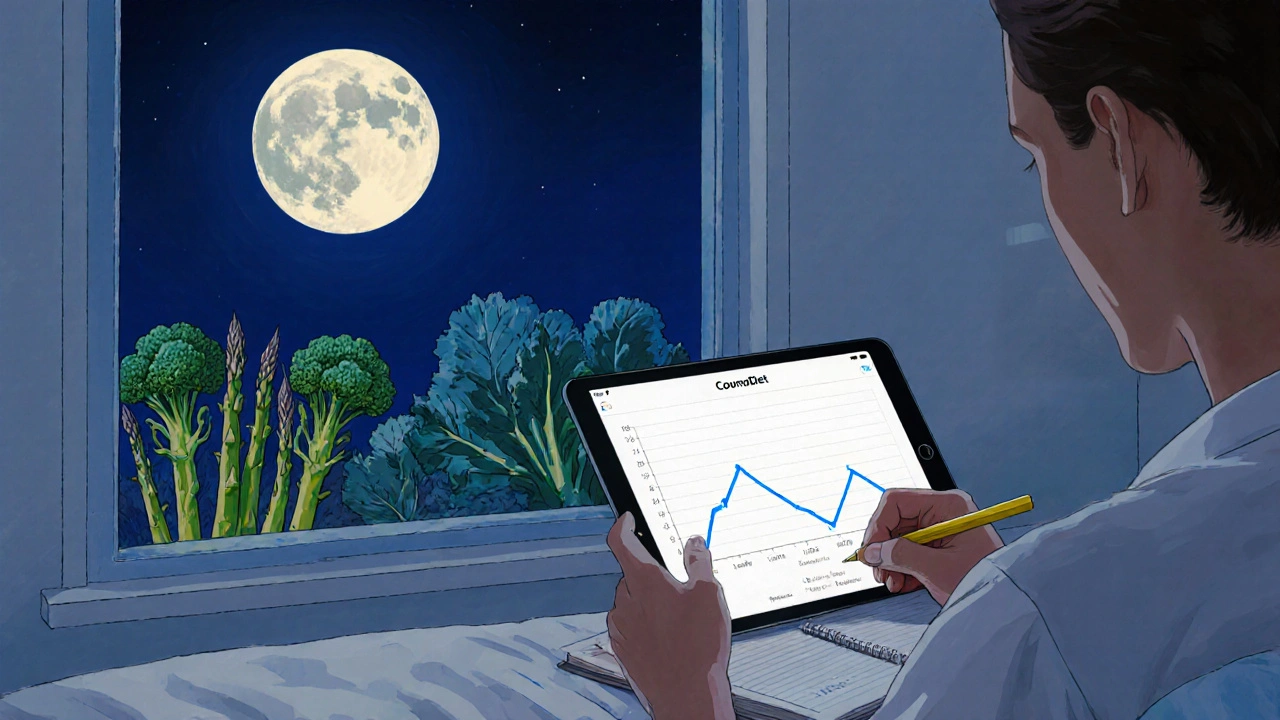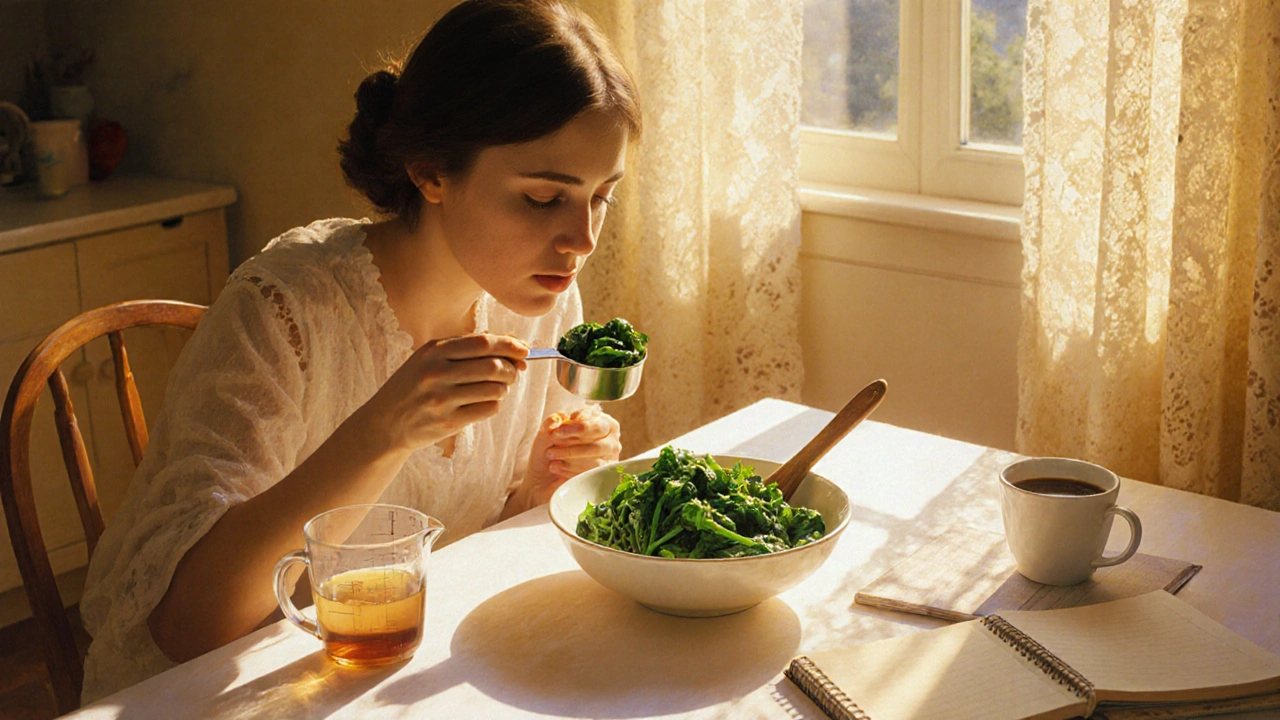Vitamin K Intake Calculator
Track Your Vitamin K Intake
Calculate your daily vitamin K intake from common foods. Consistency is key for stable INR levels while on warfarin.
The goal is to consume 90-120 µg of vitamin K daily with minimal variation.
Results
Estimated Daily Vitamin K Intake: 0 µg
Recommended Range: 90-120 µg
Consistency Tip:
For stable INR levels, try to maintain the same vitamin K intake day after day. Small variations are normal, but large changes can impact your treatment.
If you're on warfarin, you've probably heard conflicting advice about spinach, kale, and broccoli. Some people say avoid them. Others say eat them every day. The truth? Consistency is the only thing that matters. Not restriction. Not elimination. Not fear.
Why Vitamin K Matters on Warfarin
Warfarin works by blocking vitamin K from helping your blood clot. That’s why it’s effective at preventing dangerous clots in people with atrial fibrillation, deep vein thrombosis, or mechanical heart valves. But vitamin K doesn’t just come from supplements-it’s in your food. And if your intake jumps around, your INR (the number that measures how long your blood takes to clot) will swing too.Here’s what happens: if you eat a big bowl of cooked spinach one day and nothing green the next, your INR can drop overnight. That means your blood is clotting faster than it should. On the flip side, if you suddenly stop eating greens after eating them daily for weeks, your INR can spike-increasing your risk of bleeding. Neither outcome is safe.
The goal isn’t to cut out vitamin K. It’s to keep your daily intake steady. Research shows that people who eat about 90-120 micrograms (µg) of vitamin K every day, with little variation, spend 75-80% of their time in the ideal INR range (usually 2.0-3.0). People who eat inconsistent amounts? Only 55-65% of the time.
Which Foods Are High in Vitamin K?
Not all greens are created equal. Some pack a huge punch. Others are mild. Here’s what you’re really dealing with:- 1 cup cooked spinach: 889 µg
- 1 cup cooked kale: 547 µg
- 1 cup cooked collard greens: 772 µg
- 1 cup cooked broccoli: 220 µg
- 1 cup raw spinach: 145 µg
- ½ cup asparagus: 70 µg
- ½ cup green beans: 14 µg
Notice something? Cooking spinach concentrates vitamin K. That’s why raw spinach has less than half the K of cooked. Same goes for broccoli-steaming or boiling increases its concentration. If you’re used to eating raw kale in smoothies, switching to cooked kale without adjusting your dose can crash your INR.
It’s not just vegetables. Fermented foods like natto (a Japanese soy product) are extremely high in vitamin K2-up to 1,000 µg per serving. That’s enough to throw off your INR in one meal. Cheese, egg yolks, and chicken liver also contain K2, but in smaller, more manageable amounts.
Why Restriction Doesn’t Work
You might have been told to “avoid all green vegetables.” That advice is outdated-and dangerous.When patients try to eliminate vitamin K entirely, they often end up eating it anyway. Maybe it’s a salad at a friend’s house. Maybe it’s a vitamin K supplement in a multivitamin. Maybe they forget and eat a side of steamed broccoli with dinner. One unexpected high-K meal can cause a sudden drop in INR. That’s when clots form.
Dr. John Fanikos from Brigham and Women’s Hospital says it plainly: “Patients who attempt to eliminate vitamin K often experience dangerous INR fluctuations when they inadvertently consume even small amounts.”
Instead of avoidance, think consistency. Pick one high-K food you like and eat the same portion every day. If you love spinach, have one cup cooked every morning. If you prefer broccoli, have half a cup steamed with dinner. Stick to it. Don’t swap it out for kale one day and asparagus the next.
What About Supplements and Meal Replacements?
Many people don’t realize that protein shakes, meal replacements, and even some multivitamins contain vitamin K. Here’s what to watch for:- Ensure®: 50 µg per serving
- Boost®: 55 µg per serving
- Centrum Silver: 80 µg per tablet
- Many generic multivitamins: 45-100 µg
If you take one of these daily, you’re already getting close to your target intake. That’s fine-if you’re consistent. But if you take it one day and skip it the next, your INR will bounce. The same goes for probiotics or fish oil supplements that claim to “support bone health.” Some contain added vitamin K.
Always check the label. If it says “vitamin K” or “phylloquinone,” note the amount. Add it to your daily total. Then stick to the same routine every day.

Antibiotics, Illness, and Other Hidden Triggers
Your gut makes a small amount of vitamin K2 naturally. But antibiotics can wipe that out-by up to 70% in some cases. That means even if you’re eating the same food, your body might suddenly have less vitamin K. Result? Your INR goes up. You’re at higher risk of bleeding.Same thing happens when you’re sick. If you’re not eating because you have the flu or a stomach bug, your vitamin K intake drops. Your INR can rise 0.3-0.6 units in just 48 hours. That’s enough to require a doctor visit.
That’s why it’s not just about food. It’s about your whole routine. When you’re on antibiotics, tell your anticoagulation clinic. When you’re sick, monitor your INR more often. Don’t assume your usual diet will keep you stable.
How to Build a Consistent Routine
You don’t need to become a nutritionist. You just need a simple plan.- Choose one high-K food you enjoy (spinach, broccoli, kale).
- Decide on a portion size (e.g., 1 cup cooked spinach).
- Eat it at the same time every day (breakfast, lunch, or dinner).
- Don’t swap it out for another high-K food unless you’re tracking the difference.
- Use a food diary or app to log it.
Apps like CoumaDiet or INR Tracker Pro can help. They pull data from the USDA database and show you exactly how much K is in your meal. One patient in Toronto told me: “I eat exactly one cup of baby spinach daily at breakfast. My TTR jumped from 52% to 81% in six months.”
If you’re not tech-savvy, keep a notebook. Write down what you ate and when. Bring it to your INR checkups. Most anticoagulation clinics now ask for it.
What About Newer Blood Thinners?
You might be wondering: why not just switch to a newer drug like apixaban or rivaroxaban? They don’t care what you eat.True. But they cost about $3,500 a year. Warfarin? Around $150. That’s a huge difference, especially if you’re on a fixed income or don’t have good drug coverage. In Canada, many provincial plans still cover warfarin but not DOACs unless you meet specific criteria.
Plus, warfarin can be reversed quickly if you bleed. DOACs can’t. In emergencies, vitamin K or fresh frozen plasma can bring warfarin’s effect down in hours. That’s life-saving.
So if you’re doing well on warfarin, and you’re willing to manage your diet, there’s no reason to switch.

What to Do If You Mess Up
Everyone slips up. Maybe you ate three servings of kale salad. Maybe you forgot and had a smoothie with spinach. Don’t panic. Don’t double your dose. Don’t skip your next INR test.Here’s what to do:
- Call your anticoagulation clinic or pharmacist. Tell them what you ate.
- Don’t change your dose on your own.
- Get your INR checked sooner than scheduled.
- Go back to your normal routine the next day.
One Reddit user wrote: “After eating three servings of kale salad (total 1,641 µg K) while normally consuming minimal greens, my INR dropped from 2.5 to 1.8 overnight.” That’s a dangerous swing. But because he called his clinic right away, they adjusted his dose and avoided a clot.
Don’t wait. Don’t ignore it. Communication saves lives.
Common Mistakes and How to Avoid Them
- Mistake: Thinking all greens are the same. Solution: Learn the K values. Cooked spinach is 6x stronger than raw.
- Mistake: Taking vitamin K supplements without telling your doctor. Solution: Never take K supplements unless prescribed.
- Mistake: Assuming your doctor knows the latest guidelines. Solution: Print out the American Heart Association’s position on consistency and bring it to your next visit.
- Mistake: Eating inconsistent portions. Solution: Measure your food. Use a kitchen scale or measuring cups. Don’t eyeball it.
And here’s a big one: don’t trust random internet advice. A 2022 study found that 32% of hospital handouts had wrong or conflicting info. Even some nurses still tell patients to avoid greens. That’s outdated. You’re not breaking the rules by eating spinach. You’re breaking them by changing your intake.
Final Thought: It’s About Control, Not Fear
Living on warfarin isn’t about avoiding food. It’s about knowing what you’re eating-and keeping it steady. You don’t have to give up your favorite meals. You just have to make them predictable.Think of it like insulin for diabetics. You don’t avoid carbs. You learn how much you eat and match your dose. Same here. Vitamin K isn’t your enemy. Inconsistency is.
Start small. Pick one food. Eat it the same way, every day. Track it. Talk to your clinic. In 8-12 weeks, you’ll notice your INR isn’t jumping around anymore. You’ll feel more in control. And that’s worth more than any diet restriction.
Can I eat spinach if I’m on warfarin?
Yes, you can-and you should, if you eat it consistently. One cup of cooked spinach has about 889 µg of vitamin K. If you eat that same amount every day, your body adjusts, and your INR stays stable. The problem isn’t spinach. It’s switching between spinach one day and kale the next.
Should I avoid kale and broccoli on warfarin?
No. Kale and broccoli are safe if you eat them regularly in the same amount. One cup of cooked kale has 547 µg of vitamin K. If you eat that daily, your INR won’t spike. The risk comes from eating a big serving after a week of no greens. Consistency beats restriction every time.
What happens if I eat too much vitamin K one day?
Your INR will likely drop within 3-5 days, meaning your blood clots faster. This increases your risk of stroke or clotting. Don’t panic. Don’t change your dose. Call your anticoagulation clinic, get an INR test, and return to your normal routine the next day. Most people recover fine with a small dose adjustment.
Do antibiotics affect my warfarin?
Yes. Antibiotics can kill the good bacteria in your gut that make vitamin K2. That means even if you eat the same food, your body has less vitamin K. This can cause your INR to rise, increasing bleeding risk. Always tell your doctor if you’re on antibiotics while taking warfarin.
Are there apps to track vitamin K intake?
Yes. Apps like CoumaDiet and INR Tracker Pro link to USDA food databases and show you exactly how much vitamin K is in your meals. Many patients find them helpful for staying consistent. Some anticoagulation clinics even use them to adjust doses remotely.
Can I switch from warfarin to a newer blood thinner?
You can, but it’s not always necessary. Newer drugs like apixaban don’t require dietary changes, but they cost about 20 times more than warfarin. If you’re managing your vitamin K intake well and your INR is stable, there’s little reason to switch. Talk to your doctor about cost, coverage, and your personal health goals.
If you’re feeling overwhelmed, start with one change: pick one food you eat now, and make it your daily vitamin K source. Measure it. Log it. Stick to it. That’s all it takes to get your INR steady-and your peace of mind back.






Comments
Katelyn Sykes
17 November 2025Just started eating a cup of cooked spinach every morning with my eggs and my INR hasn’t budged in 3 months. No more panic visits to the clinic. It’s not about avoiding greens it’s about making them part of your routine like brushing your teeth
Gabe Solack
18 November 2025This is the best warfarin advice I’ve ever read 🙌 I used to avoid everything green until my INR went haywire. Now I eat the same amount of broccoli every night. Life changed. Also stop listening to nurses who say 'just avoid spinach'-they’re still stuck in 2008
Yash Nair
19 November 2025why do americans make everything so complicated i eat spinach every day and dont even know what vitamin k is my grandpa took warfarin for 20 years and never had a problem he just ate what he wanted
Bailey Sheppard
21 November 2025Consistency is everything. I used to switch between kale, spinach, and broccoli thinking I was being 'healthy'-turns out I was just making my INR dance. Now I eat one cup of steamed broccoli every dinner. Simple. Predictable. Stable. You don’t need to be perfect, just consistent.
Girish Pai
22 November 2025From an Indian perspective, this is textbook anticoagulation management. The K2 content in natto is clinically significant-most Western clinicians underestimate its potency. Also, probiotic-induced gut flora modulation can reduce endogenous K2 synthesis by up to 70% per recent RCTs. Track your intake with validated tools like CoumaDiet, not anecdotal blogs.
Kristi Joy
22 November 2025For anyone feeling overwhelmed-start with one thing. One food. One time of day. Doesn’t matter if it’s spinach or green beans. Just make it yours. Your body will thank you. You’re not failing if you slip up. You’re learning. Keep going.
Hal Nicholas
23 November 2025I told my doctor I was eating kale daily and she acted like I was poisoning myself. Meanwhile, my INR was perfect. Now I just lie and say I eat 'a little salad.' Who needs a 12-page guide when common sense works? Also, why do people trust apps more than their own experience?
Louie Amour
25 November 2025Anyone who thinks this is 'just about consistency' clearly hasn’t dealt with real anticoagulation chaos. You think your broccoli routine matters when your pharmacist changes your dose without telling you? Or when your insurance drops coverage? This whole system is a joke. You’re not controlling your INR-you’re just surviving it.
Kristina Williams
26 November 2025Did you know vitamin K is used in rat poison? They put it in the same family. Your doctor is lying to you. They want you to eat spinach so they can keep you on warfarin forever because the pharma companies pay them. Check the FDA documents-K2 is a controlled substance in 14 countries. Why not in yours?
Shilpi Tiwari
28 November 2025Interesting that the USDA database doesn’t account for regional soil variations in K content. A study from Punjab showed spinach grown in alkaline soil had 37% higher phylloquinone than coastal varieties. If you’re tracking intake, you need to factor in origin-not just cooking method. Also, fermentation time in natto affects K2 isoform ratio-MK-7 vs MK-9 matters for half-life.
Christine Eslinger
29 November 2025There’s a quiet beauty in this-how something as simple as eating the same spinach every day becomes an act of self-respect. It’s not about control. It’s about showing up for your body, day after day, even when no one’s watching. Warfarin doesn’t ask for perfection. It asks for presence. And that’s something no app can give you.
Denny Sucipto
30 November 2025I used to think I was being healthy by chowing down on kale smoothies every morning. Then my INR went to 4.8 and I ended up in the ER with a nosebleed that wouldn’t stop. Now I eat one cup of cooked broccoli every night. No more drama. No more fear. Just dinner. And yeah, I still sneak in a handful of raw spinach on weekends. Life’s too short to be scared of greens.
Holly Powell
30 November 2025Let’s be real: this advice is only viable for people with the luxury of time, access to USDA databases, and the cognitive bandwidth to log meals. Most patients are working two jobs, managing chronic pain, and raising kids. Telling them to 'eat one cup of spinach daily' is classist nonsense. The system is broken. The burden shouldn’t be on the patient.
Emanuel Jalba
2 December 2025WHY IS NO ONE TALKING ABOUT THE FACT THAT VITAMIN K IS A BIG PHARMA TRAP?? 🤯 THEY WANT YOU TO THINK YOU CAN EAT SPINACH BUT ONLY IF YOU TRACK IT. WHAT IF THEY’RE THE ONES WHO MADE YOU THINK YOU NEEDED TO TRACK IT IN THE FIRST PLACE?? I’M GOING OFF WARFARIN AND SWITCHING TO NATURAL REMEDIES. #VitaminKIsAManipulation
Heidi R
3 December 2025Stop. Just stop. You’re not 'managing' anything. You’re being manipulated by a system that profits from your anxiety. Eat what you want. Your INR will find its own balance. Or don’t. Either way, you’re not the problem.